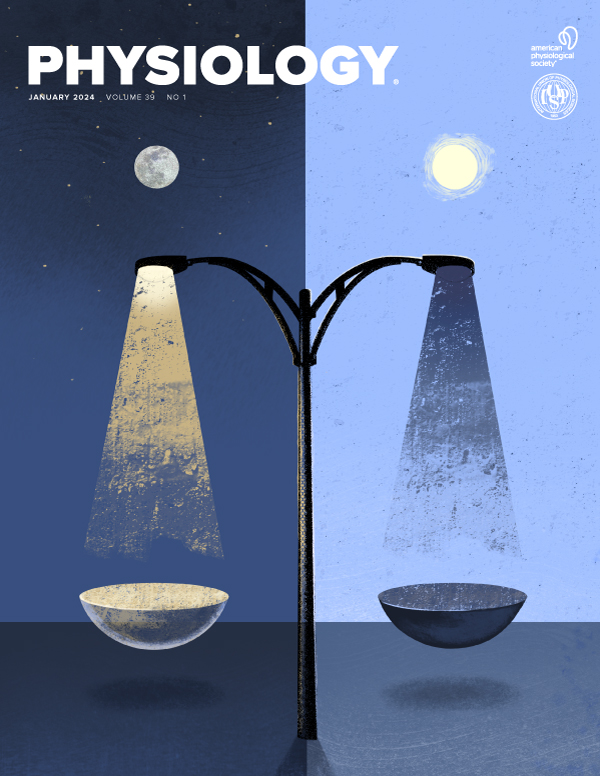Role of Leptin in Regulating Renal Phosphate Transport
IF 5.3
2区 医学
Q1 PHYSIOLOGY
引用次数: 0
Abstract
Elevated plasma phosphate (Pi) levels, known as hyperphosphatemia, are associated with an increased risk of cardiovascular complications and mortality. Although studies have suggested a correlation between obesity and hyperphosphatemia/phosphate toxicity, the root cause of this observation has not been established. Since hyperleptinemia was also found to be associated with abnormalities in bone structure, we hypothesized that effects on renal Pi transport are responsible for this observation. To address this question, we studied hyperleptinemic mice (db/db, n=14) and compared them to wild-type mice (WT, n=10). Blood and urine samples, as well as kidney tissues, were collected and analyzed. Body weight was approximately twice as high in db/db compared to WT mice (59±3 vs. 30±2 g, P<0.05). Plasma Pi levels in db/db mice were significantly greater (~1.5-fold) compared to WT mice (2.6±0.1 vs. 1.7±0.1 mmol/L, P<0.05). However, urinary Pi /creatinine ratios were similar between genotypes. Plasma Ca2+ levels in db/db mice were significantly higher compared to WT mice (2.68±0.03 vs. 2.48±0.03 mmol/L, P<0.05) alongside urinary Ca2+/creatinine ratios being significantly higher in db/db mice compared to WT mice (1.6±0.4 vs. 0.3±0.1 mmol/mmol, P<0.05). Plasma parathyroid hormone (PTH, regulating Pi and Ca2+) levels were similar in both genotypes. The phosphaturic hormone fibroblast growth factor 23 (FGF23), which is produced and released from bone, was slightly but significantly elevated in db/db compared to WT mice (254±12 vs. 227±18 pg/mL, P<0.05). Bone formation markers (osteocalcin and procollagen type I N-propeptide) and bone resorption markers (tartrate-resistant acid phosphatase 5b and C-terminal telopeptide of type I collagen) were similar between genotypes, indicating that Pi and Ca2+ release from bone may not be causing these mineral differences. To determine the role of the kidney for the development of hyperphosphatemia, we performed 32P radiotracer studies in acutely isolated renal brush border membrane vesicles. Sodium-dependent 32P transport was not significantly different between genotypes. To determine the ambient in vivo contribution of the Na+-Pi cotransporter Npt2a, we employed acute pharmacological inhibition with PF-06869206 (Npt2a inhibitor, 30 mg/kg b.w, n=7) or vehicle (n=11) and compared plasma Pi before and 2 hours after administration in db/db mice. Vehicle treatment slightly increased plasma Pi levels compared to baseline (2.6±0.1 vs. 2.1±0.1 mmol/L, P<0.05); in contrast, the Npt2a inhibitor significantly reduced (~50%) plasma Pi levels compared to baseline (1.3±0.1 vs. 2.5±0.1 mmol/L, P<0.05). In summary, our study demonstrates that hyperphosphatemia in db/db mice is not caused by changes in renal Pi transport or bone turnover, suggesting that possibly intestinal mechanisms are responsible for increased Pi, and possibly Ca2+, absorption. Of note, Npt2a inhibition was effective in reducing hyperphosphatemia in db/db mice, indicating a potential therapeutic strategy. This work was supported by a VA Merit Review Award IBX004968A (to Dr. Rieg) and a Pilot Project from the USF Microbiomes Institute (to T.R. and J.D.R). This is the full abstract presented at the American Physiology Summit 2024 meeting and is only available in HTML format. There are no additional versions or additional content available for this abstract. Physiology was not involved in the peer review process.瘦素在调节肾脏磷酸盐转运中的作用
血浆磷酸盐(Pi)水平升高,即高磷血症,与心血管并发症和死亡风险增加有关。尽管有研究表明肥胖与高磷酸盐血症/磷酸盐中毒之间存在关联,但这一观察结果的根本原因尚未确定。由于高瘦血症也被发现与骨结构异常有关,因此我们推测,对肾脏Pi转运的影响是导致这一观察结果的原因。为了解决这个问题,我们研究了高瘦素血症小鼠(db/db,n=14),并将它们与野生型小鼠(WT,n=10)进行了比较。我们收集并分析了血液和尿液样本以及肾脏组织。与 WT 小鼠相比,db/db 小鼠的体重约为 WT 小鼠的两倍(59±3 vs. 30±2 g,P<0.05)。与 WT 小鼠相比,db/db 小鼠的血浆 Pi 水平明显更高(~1.5 倍)(2.6±0.1 vs. 1.7±0.1 mmol/L,P<0.05)。然而,不同基因型之间的尿 Pi / 肌酐比率相似。与 WT 小鼠相比,db/db 小鼠的血浆 Ca2+ 水平明显更高(2.68±0.03 vs. 2.48±0.03 mmol/L,P<0.05),同时与 WT 小鼠相比,db/db 小鼠的尿 Ca2+ / 肌酸酐比率也明显更高(1.6±0.4 vs. 0.3±0.1 mmol/mmol,P<0.05)。两种基因型小鼠的血浆甲状旁腺激素(PTH,调节 Pi 和 Ca2+)水平相似。磷酸化激素成纤维细胞生长因子 23(FGF23)从骨中产生并释放,与 WT 小鼠相比,db/db 小鼠的 FGF23 略有升高,但升高显著(254±12 对 227±18 pg/mL,P<0.05)。不同基因型之间的骨形成标志物(骨钙素和 I 型胶原 N-脯氨酸)和骨吸收标志物(耐酒石酸磷酸酶 5b 和 I 型胶原 C 端端肽)相似,这表明骨中的 Pi 和 Ca2+ 释放可能不是造成这些矿物质差异的原因。为了确定肾脏在高磷血症发生中的作用,我们在急性分离的肾刷状缘膜囊泡中进行了 32P 放射性示踪剂研究。钠依赖性 32P 转运在不同基因型之间没有显著差异。为了确定 Na+-Pi 共转运体 Npt2a 在体内的环境贡献,我们使用 PF-06869206 (Npt2a 抑制剂,30 毫克/千克体重,n=7)或药物(n=11)进行急性药理抑制,并比较了 db/db 小鼠用药前和用药 2 小时后的血浆 Pi。与基线相比,车辆治疗略微增加了血浆 Pi 水平(2.6±0.1 vs. 2.1±0.1 mmol/L,P<0.05);相反,与基线相比,Npt2a 抑制剂显著降低了血浆 Pi 水平(约 50%)(1.3±0.1 vs. 2.5±0.1 mmol/L,P<0.05)。总之,我们的研究表明,db/db 小鼠的高磷血症不是由肾脏 Pi 转运或骨转换的变化引起的,这表明肠道机制可能对 Pi 以及 Ca2+ 吸收的增加负责。值得注意的是,抑制 Npt2a 能有效降低 db/db 小鼠的高磷血症,这表明这是一种潜在的治疗策略。这项工作得到了退伍军人功绩评审奖 IBX004968A(授予 Rieg 博士)和 USF 微生物组研究所试点项目(授予 T.R. 和 J.D.R)的支持。这是在 2024 年美国生理学峰会上发表的摘要全文,只有 HTML 格式。本摘要没有附加版本或附加内容。生理学》未参与同行评审过程。
本文章由计算机程序翻译,如有差异,请以英文原文为准。
求助全文
约1分钟内获得全文
求助全文
来源期刊

Physiology
医学-生理学
CiteScore
14.50
自引率
0.00%
发文量
37
期刊介绍:
Physiology journal features meticulously crafted review articles penned by esteemed leaders in their respective fields. These articles undergo rigorous peer review and showcase the forefront of cutting-edge advances across various domains of physiology. Our Editorial Board, comprised of distinguished leaders in the broad spectrum of physiology, convenes annually to deliberate and recommend pioneering topics for review articles, as well as select the most suitable scientists to author these articles. Join us in exploring the forefront of physiological research and innovation.
文献相关原料
| 公司名称 | 产品信息 | 采购帮参考价格 |
|---|
 求助内容:
求助内容: 应助结果提醒方式:
应助结果提醒方式:


